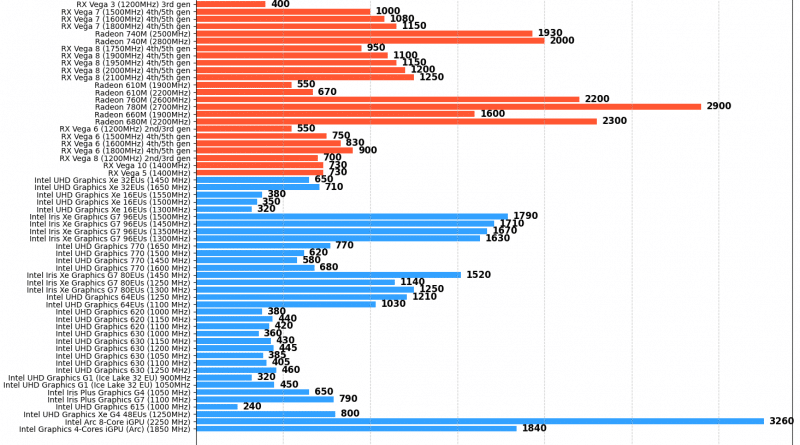Integrated Laptop Graphics Card: Guide & Comparison Chart
If you’re buying a laptop for gaming, video editing, or 3D design — and you’re not going with a dedicated GPU — you’ll probably face this dilemma:
Two laptops. Same price. Similar CPUs. But one of them has better integrated graphics.
A good rule of thumb? Choose the newest or fastest CPU — it usually brings the better iGPU. But that’s not always a sure thing.
That’s why I built this guide — a complete comparison chart of all the integrated GPUs that matter. I’ll also explain:
- 📊 How the chart was made
- 🔬 Which benchmarks were used
- 🧭 How to interpret the performance results
- Most importantly: What iGPUs will you find on an specific laptop CPU!
🎯 Just want a shortlist of the best laptops with strong iGPUs under $500?
👉 Click here for my top picks — this short list has been compiled from all the recent laptops models available online (~300).
Integrated GPU basics
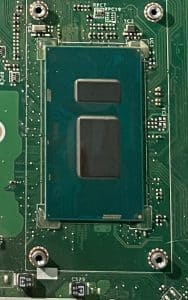
Because this site is geared toward readers who aren’t super tech-savvy, I’m going to walk through a few integrated graphics basics first. That way, you can better understand how your laptop’s iGPU might actually perform in the real world.
If you’re already familiar with this stuff and just want to see the benchmark results, feel free to skip ahead using the table of contents.
⚠️ Quick heads up: Just because two laptops have iGPUs with the same name doesn’t mean they’ll perform the same.
Performance can differ depending on factors like:

- Clock rate: It’s common for integrated GPUs to have higher clock speeds across different laptops.
- Shaders/EUs/Cores: EUs (execution units), shaders and cores are terms meaning “processing units”. The more processing units (regardless of name), the faster the performance of an iGPU.

- Generation: Some integrated GPUs share the same name and maybe even the same clock rate but they are from a different generation. On AMD, its usually labeled as (3000/4000) and Intel uses the CPUs generation name.
List of Laptop Integrated GPUs from AMD & Intel (2018 to present)
What follows is a benchmark comparison table featuring every integrated GPU found in laptops from 2018 to 2025 — focusing only on Intel Core and AMD Ryzen CPUs (no Celeron, Pentium, or other low-end chips).
The right column lists which CPUs each iGPU belongs to, so you can easily match a laptop’s processor to its expected graphics performance.
You’ll also see important specs like clock speed and shader count (EUs or CUs) — and yes, as a general rule: more = better performance.
📊 Heads up: This table is great for quick reference, but it’s not the most user-friendly if you’re trying to visually compare performance.
If you’re more of a visual learner, don’t worry — the interactive benchmark graph is coming up next to make comparisons easier and more intuitive.
Laptop Integrated GPUs found on AMD CPUs
| GPU | Clock Speed | Found in CPUs |
| AMD Radeon RX Vega 5 | 1400 MHz | Ryzen 3 4300U |
| AMD Radeon RX Vega 6 (2000/3000) | 1200 MHz |
Ryzen 3 3300U, Ryzen 3 3000U
|
| AMD Radeon RX Vega 8 (2000/3000) | 1200 MHz |
Ryzen 5 3500U, Ryzen 5 3550H
|
| AMD Radeon RX Vega 10 | 1400 MHz |
Ryzen 7 3750H, Ryzen 7 3700U
|
| RX Vega 3 | 1200 MHz |
Ryzen 3 3200U, Ryzen 3 3250U
|
| AMD Radeon RX Vega 7 (4000/5000) | 1500 MHz | Ryzen 4680U |
| 1600 MHz |
Ryzen 7 4700U, Ryzen 7 4800U, Ryzen 7 4800H
|
|
| 1800 MHz |
Ryzen 5 5600U, Ryzen 5 5600H
|
|
| 2000 MHz | Ryzen 5 7530U | |
| AMD RX Vega 8 (4000-5000) |
1750 MHz |
Ryzen 7 4800U, Ryzen 9 4900H, Ryzen 9 4900HS
|
| 1900 MHz | Ryzen 7 5700U | |
| 1950 MHz | Ryzen 7 4980U | |
| 2000 MHz |
Ryzen 7730U, Ryzen 7 5800U, Ryzen 7 5800H, Ryzen 7 5800HS
|
|
| 2100 MHz |
Ryzen 9 5900H, Ryzen 9 5900HX, Ryzen 9 5900HS
|
|
| AMD Radeon 610M | 1900 MHz | Ryzen 3 7420U |
| 2200 MHz |
Ryzen 7 7745HX, Ryzen 7 7845HX, Ryzen 9 7845HX, Ryzen 9 7945HX
|
|
| AMD Radeon RX Vega 6 (4th/5th) | 1500 MHz |
Ryzen 5 4600U, Ryzen 5 4600H, Ryzen 3 5300U, Ryzen 5 5500U
|
| 1600 MHz |
Ryzen 3 5400U, Ryzen 5 5560U
|
|
| 1800 MHz | Ryzen 3 7330U | |
| AMD Radeon 740M | 2500 MHz | Ryzen 5 7540U |
| 2800 MHz | Ryzen 5 7545U | |
| AMD Radeon 760M | 2600 MHz |
Ryzen 5 7640U, Ryzen 5 8640HS
|
| AMD Radeon 780M | 2700 MHz |
Ryzen 7 7840U, Ryzen 7 8845HS
|
| AMD Radeon 660M | 1900 MHz |
Ryzen 5 6600U, Ryzen 5 6600H
|
| AMD Radeon 680M | 2200 MHz |
Ryzen 7 6800H, Ryzen 7 6800U+
|
Laptop Integrated GPUs found on Intel CPUs
| GPU | Clock Speed | Found in CPUs |
| Intel UHD Graphics 620 | 1000 MHz |
Core i3-8130U, Core i5-8250U, Core i5-8350U, Core i3-8100H, Core i5-8300H, Core i3-8145U, Core i3-10110U
|
| 1150 MHz |
Core i7-8550U, Core i7-8650U, Core i7-10510U, Core i7-10610U, Core i7-10710U, Core i7-10810U, Core i5-10310U
|
|
| 1100 MHz | Core i5-10210U | |
| Intel UHD Graphics 630 | 1000 MHz | Core i5-8300H, Core i5-8400H, Core i7-8750H |
| 1150 MHz | Core i7-8850H, Core i7-9750H, Core i7-9850H | |
| 1200 MHz | Core i9-8950HK, Core i9-9880H | |
| 1050 MHz | Core i5-9300H | |
| 1100 MHz | Core i5-9400H, Core i5-10400H | |
| 1250 MHz | Core i9-9980HK | |
| Intel UHD Graphics G1 (Ice Lake) | 900 MHz | Core i3-1005G1 |
| 1050 MHz | Core i5-1035G1 | |
| Intel Iris Plus Graphics G4 | 1050 MHz | Core i5-1035G4 |
| Intel Iris Plus Graphics G7 | 1100 MHz | Core i7-1065G7 |
| Intel UHD Graphics 615 | 1000 MHz | Core i3-10100H |
| Intel UHD Graphics Xe 32EUs | 1450 MHz | Core i7-11800H, Core i9-11950H, Core i9-11900H |
| 1650 MHz | Core i9-14900HX | |
| Intel UHD Graphics Xe 16EUs | 1550 MHz | Core i5-13650HX |
| 1500 MHz | Core i5-14450HX | |
| 1300 MHz | Core i5-12450HX | |
| Intel Iris Xe Graphics G7 96EUs | 1500 MHz |
Core i7-13700H, Core i9-13900HK, Core i7-1360P, Core i7-13800H, Core i9-13900H
|
| 1450 MHz | Core i9-12900HK, Core i7-1280P, Core i9-12900H | |
| 1350 MHz | Core i7-11370H, Core i7-1185G7 | |
| 1300 MHz | Core i7-1165G7, Core i7-1355U | |
| Intel UHD Graphics 770 | 1650 MHz | Core i9-13980HX, Core i9-13950HX |
| 1500 MHz |
Core i5-13600HX, Core i7-13700HX, Core i9-12950HX
|
|
| 1450 MHz | Core i7-12800HX | |
| 1600 MHz | Core i7-14700HX | |
| Intel Iris Xe Graphics G7 80EUs | 1450 MHz | Core i5-1340P |
| 1250 MHz | Core i5-1334U | |
| 1300 MHz |
Core i5-1135G7, Core i5-1145G7, Core i5-11300H, Core i5-12500H, Core i5-1240P
|
|
| Intel UHD Graphics 64EUs | 1250 MHz | Core i3-1315U |
| 1100 MHz | Core i3-1215U | |
| Intel UHD Graphics Xe G4 48EUs | 1250 MHz | Core i3-1115G4, Core i3-1125G4 |
| Intel Arc 8-Core iGPU | 2250 MHz | Ultra 7 155H |
| 2350 MHz | Ultra 9 185H 16C | |
| Intel Graphics 4-Core iGPU (Arc) | 1850 MHz | Intel Ultra 5-125U |
Laptop Integrated GPU Performance Comparison
To test the relative performance of iGPUs we will use benchmarks.
Benchmarks are just tests to see how well a hardware performs. Now there are several different benchmarks but for this post we will focus on 3D Mark Time Spy benchmarks because:
- Primarily measures how well the GPU handles complex 3D scenes, textures, shading, lighting, and rendering.
- Ignores CPU and other hardware into the results and ONLY FOCUSES on measuring the raw power of the GPU.
- It is ALSO relevant for 3D work & accelerate effects in video editing and photo editing.
- Unlike other benchmarks (3DMark Fire Strike Graphics) it uses DirectX 12 (latest API for the latest games).
Note: We will present the results in three parts AMD, Intel and AMD vs Intel because the graph is too big. Note that this should not be the only factor for performance comparison but rather to get an stimate of how much faster is a GPU relative to others. You must take into account other factors which I discuss shortly after.
AMD iGPUs Performance (Laptop)
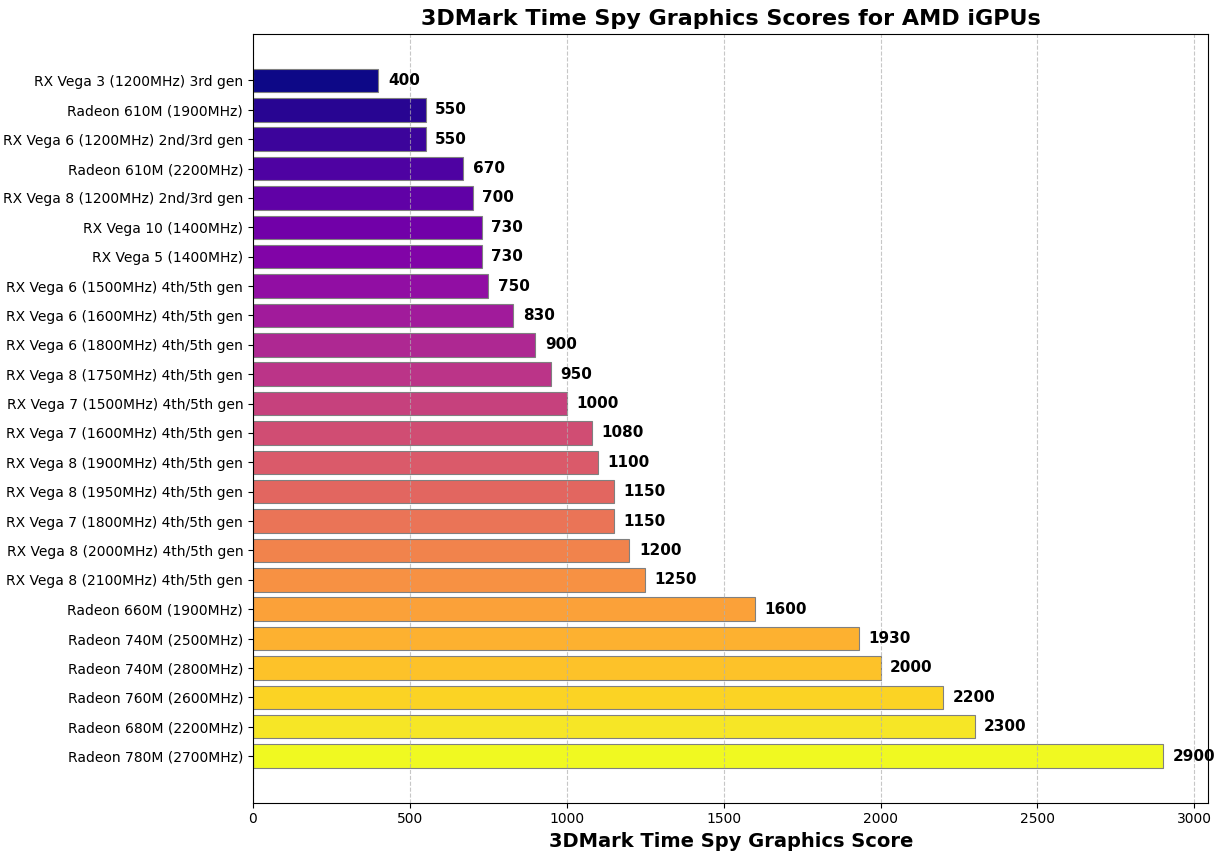
Intel iGPUs Performance (Laptop)
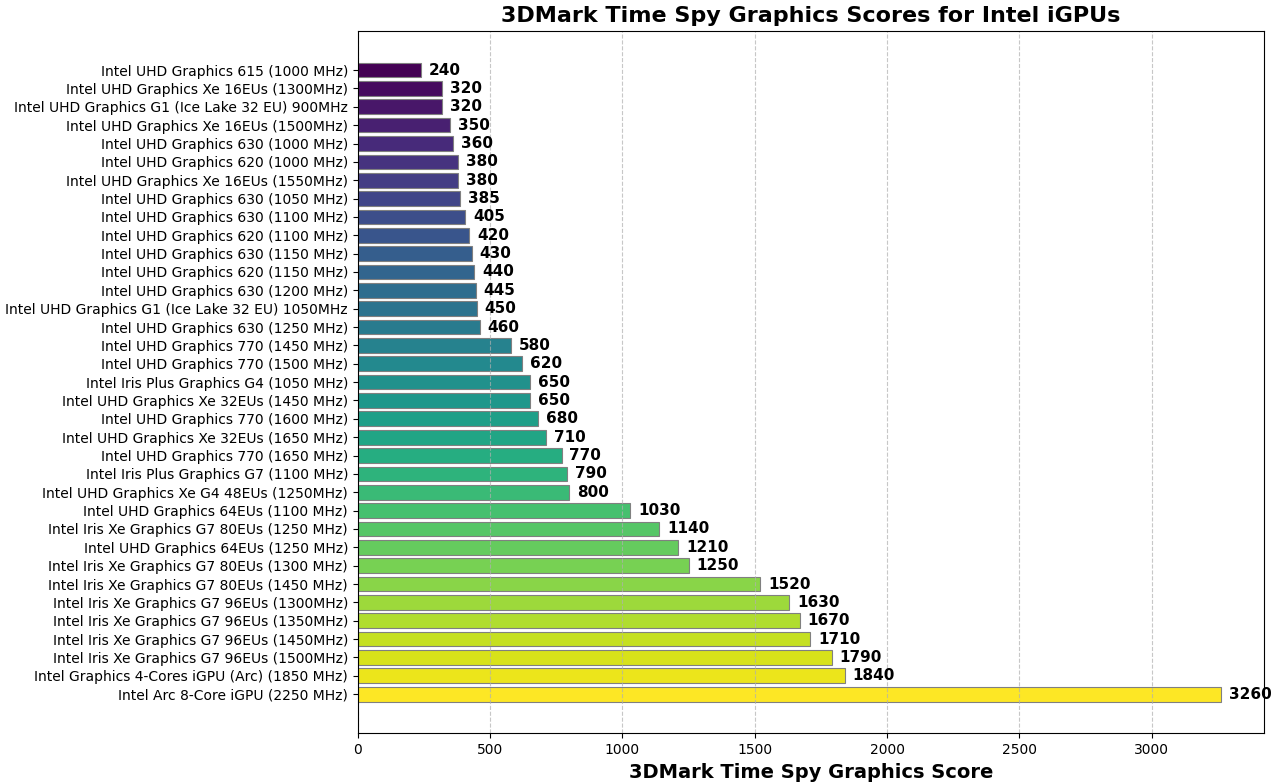
AMD vs Intel GPUs iGPU Performance Comparison
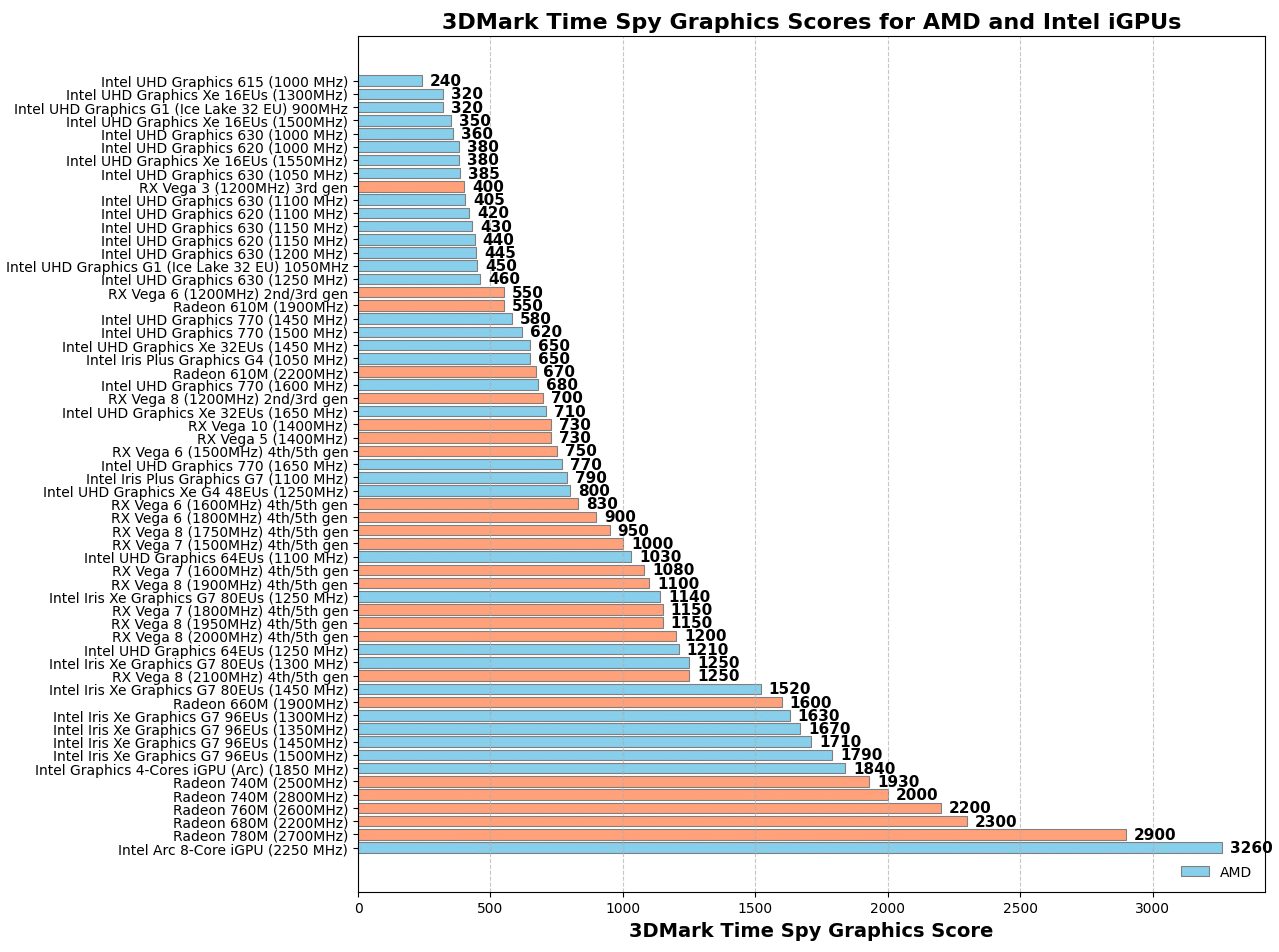
How were the results obtained?
I took the results for a iGPU at a given clock rate with the specified number of processing units and calculated the median from both notebookcheck and 3DMark website. The median is a much better measurement because unlike the average it’s not influenced by the the outliers (results which are not common.
When there was NO benchmarks for a given GPU (which is usually the case for integrated GPUs running at higher clock speeds or more processing units), I extrapolated the values based on faster clock speeds and lower clock speeds graphics score values.
Note: The performance of each integrated GPU will depend on the power supplied to the CPU (thus the iGPU). Higher power supplied means it can run at higher clock speeds. RAM and the presence of a dedicated GPU can also affect the benchmark scores but we tried to minimize these effects by taking the median and ignoring outliers (systems that scored too high).
Author Profile
- I am physicist and electrical engineer. My knowledge in computer software and hardware stems for my years spent doing research in optics and photonics devices and running simulations through various programming languages. My goal was to work for the quantum computing research team at IBM but Im now working with Astrophysical Simulations through Python. Most of the science related posts are written by me, the rest have different authors but I edited the final versions to fit the site's format.
Latest entries
 LaptopsNovember 26, 2025Black Friday Week Deals 2025 (Updated Nov 28 1:37PM)!!!
LaptopsNovember 26, 2025Black Friday Week Deals 2025 (Updated Nov 28 1:37PM)!!! LaptopsJune 30, 2025Best Laptops for Computer Science (July 2025 )
LaptopsJune 30, 2025Best Laptops for Computer Science (July 2025 ) LaptopsJune 29, 20255 Best Laptops For Nursing Students (July 2025)
LaptopsJune 29, 20255 Best Laptops For Nursing Students (July 2025) LaptopsJune 19, 20255 Best Laptops For Teachers in 2025 (From $250)
LaptopsJune 19, 20255 Best Laptops For Teachers in 2025 (From $250)
